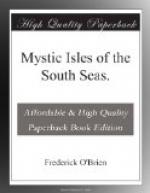This man and woman made a deep impression upon me. They had seen cities everywhere, had had position and fashion, and were, for their advanced kind, at peace.
“We have no nerves here,” said Mrs. Lermontoff. “Our neighbors are all fishermen, and we are friends. We drink no wine, we want no tobacco. We have health and nature; books and music supply our interests. Life is placid, even sweet.”
When I bade them good-by it was with regret. They had found a refuge, and they had love, and yet they wanted to aid in the revolution they believed in. I restrained myself from pointing out that Tolstoi, at the last, forsook even his family to seek solitude and die.
Chapter XXI
A heathen temple—The great Marae of Oberea—I visit it with Rupert Brooke and Chief Tetuanui—The Tahitian religion of old—The wisdom of folly.
Reading one day from Captain Cook’s Voyages about a heathen temple not far from Mataiea which Cook had visited, I suggested to Brooke that we go to it. None of the Tetuanui younger folk had seen it, but Haamoura directed us to return toward Papara as far as the thirty-ninth kilometer-stone, and to strike from that point towards the beach. Cook had had a sincere friendship, if not a sweeter sentiment, for Oberea, the high chiefess of the clan of Tevas at Papara, and whom at first he thought queen of Tahiti. He described her as “forty years of age, her figure large and tall, her skin white, and her eyes with great expression.” That handsome lady had led him a merry chase, her complacent husband, Oamo, abetting her in the manner of Polynesia, where women must have their fling. The temple Cook and his officers inspected was the tribal church of the noble pair. The Voyages say:
The morai consisted of an enormous pile of stone work, raised in the form of a pyramid with a flight of steps on each side, and was nearly two hundred and seventy feet long, about one-third as wide, and between forty and fifty feet high. As the Indians were totally destitute of iron utensils to shape their stones, as well as mortar to cement them when they had made them fit for use, a structure of such height and magnitude must have been a work of infinite labor and fatigue. In the center of the summit was the representation of a bird, carved in wood; close to this was the figure of a fish which was in stone. This pyramid made part of one side of a wide court or square, the sides of which were nearly equal; the whole was walled in, and paved with flat stones.
When we reached the thirty-ninth kilometer-stone we met my host, Tetuanui, in his one-horse vehicle, inspecting the road. He agreed, though a little reluctantly, to take us to the marae (pronounced mah-rye). We turned down a road across a private, neglected property, and for almost a mile urged the horse through brambles and brush that had overgrown the way. We were going toward the sea along a promontory, “the point” upon which Cook’s mariners saw the etoa-trees a century and a half ago, about the time that Americans were seeking separation from England, before Napoleon had risen to power, and when gentlemen drank three bottles of port after dinner and took their places under the table.




